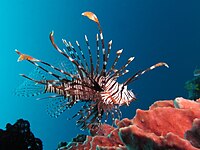
Photo from wikipedia
Culling can be an effective management tool for reducing populations of invasive species to levels that minimize ecological effects. However, culling is labour-intensive, costly, and may have unintended ecological consequences.… Click to show full abstract
Culling can be an effective management tool for reducing populations of invasive species to levels that minimize ecological effects. However, culling is labour-intensive, costly, and may have unintended ecological consequences. In the Caribbean, culling is widely used to control invasive Indo-Pacific lionfish, Pterois volitans and P. miles, but the effectiveness of infrequent culling in terms of reducing lionfish abundance and halting native prey decline is unclear. In a 21-month-long field experiment on natural reefs, we found that culling effectiveness changed after the passage of a hurricane part-way through the experiment. Before the hurricane, infrequent culling resulted in substantial reductions in lionfish density (60–79%, on average, albeit with large uncertainty) and slight increases in native prey species richness, but was insufficient to stem the decline in native prey biomass. Culling every 3 months (i.e., quarterly) and every 6 months (i.e., biannually) had similar effects on lionfish density and native prey fishes because of high rates of lionfish colonization among reefs. After the hurricane, lionfish densities were greater on all culled reefs compared to non-culled reefs, and prey biomass declined by 92%, and species richness by 71%, on biannually culled reefs. The two culling frequencies we examined therefore seem to offer a poor trade-off between the demonstrated conservation gains that can be achieved with frequent culling and the economy of time and money realized by infrequent culling. Moreover, stochastic events such as hurricanes can drastically limit the effectiveness of culling efforts.
Journal Title: Biological Invasions
Year Published: 2017
Link to full text (if available)
Share on Social Media: Sign Up to like & get
recommendations!